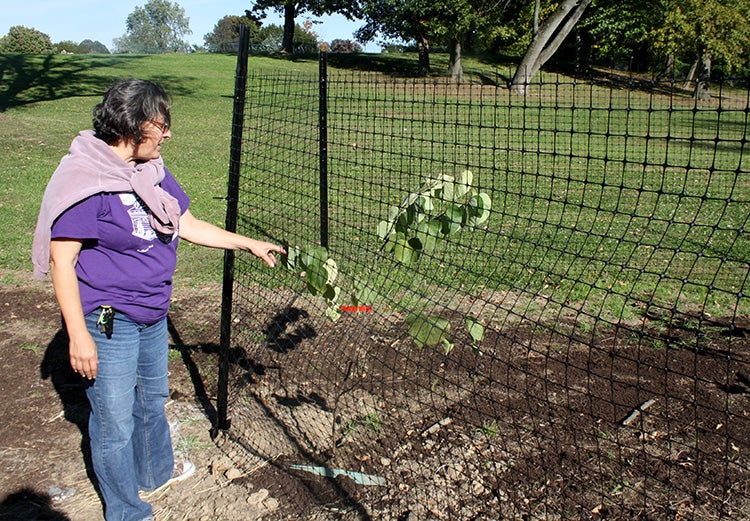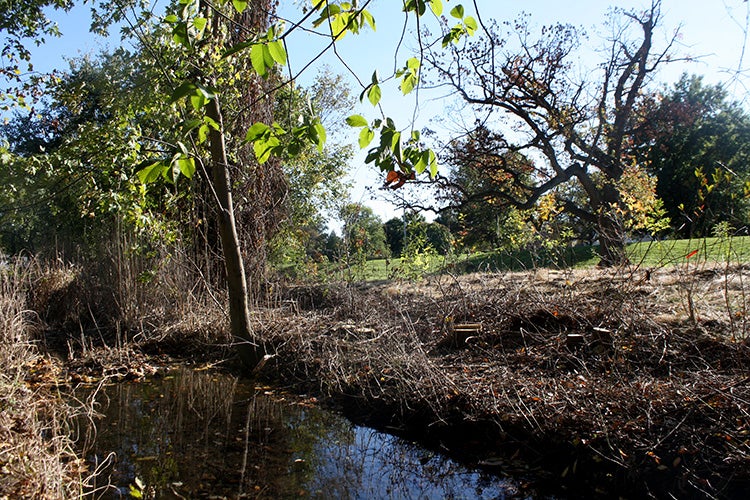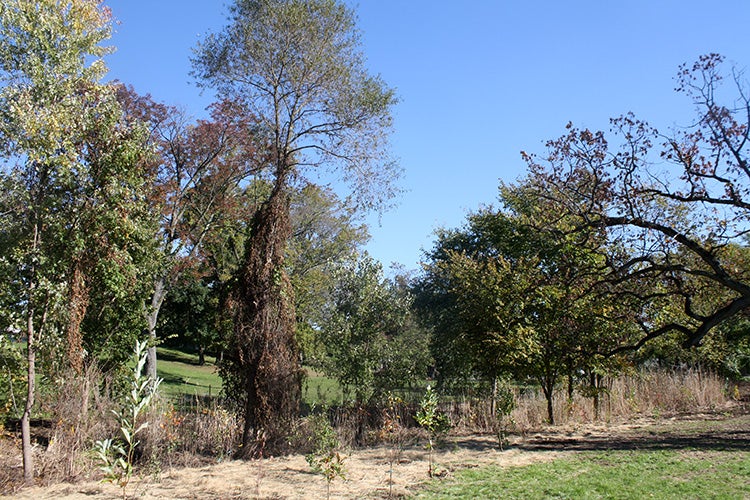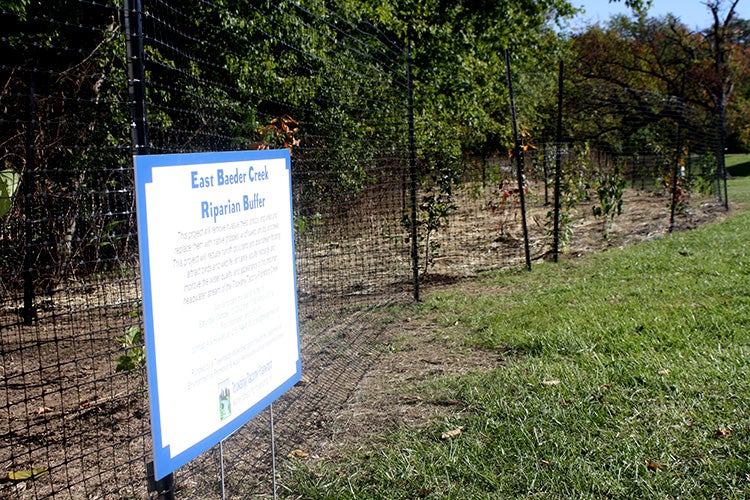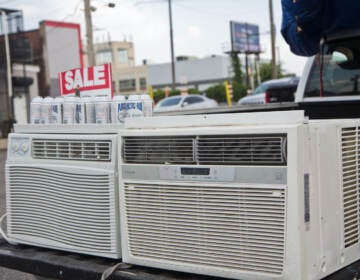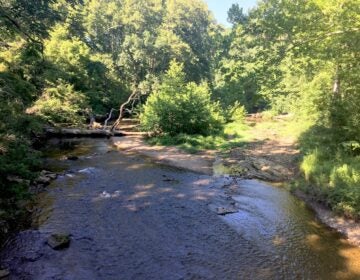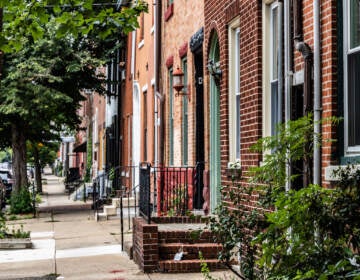Watershed partnership plants riparian buffer at Abington Junior High
“It starts, like, over there,” said Julie Slavet, pointing toward a soccer field on the campus of Abington Junior High School, six or so miles north of Philadelphia, in Montgomery County.
It was a Saturday afternoon, and Slavet, the 54-year-old director of the Tookany/Tacony-Frankford Watershed Partnership (TTF), was seated on a curb in the school parking lot. She waved her hand, as though tossing a handful of feed to a brood of chickens, to indicate the underground headwaters of Baeder Creek—headwaters, in fact, of the entire TTF watershed system.
A riparian buffer planting had been scheduled from 10 in the morning until 4 in the afternoon. But the weather was remarkable and the turnout high, and by the time a reporter arrived shortly before 3, the work was done. Slavet recounted the day’s events.
Seventy-five volunteers, mostly kids, had planted 300 trees, wildflowers, grasses, and shrubs along a short stretch of the creek, which begins beneath a soccer field, surfaces across the entrance to the school and winds southeast before dumping its contents into the Tookany Creek, then the Tacony Creek, the Frankford Creek, and the Delaware River.
The plants were native species. They’d been purchased—bladdernut, persimmon, pawpaw, and river birch trees; silky dogwood, winterberry, and summersweet shrubs—from two nurseries in Glenside, Pennsylvania, and Columbus, New Jersey. As they grow, they’ll filter pollutants out of the storm water that rushes into Baeder Creek. Their roots will strengthen its banks. And the Tookany, Tacony, Frankford, and Delaware waterways will all be cleaner for it, if only minutely.
The TTF Watershed Partnership was started in 2000 by the Philadelphia Water Department in order “to connect diverse stakeholders as neighbors and stewards of the watershed,” according to the organization’s website. It helped develop an integrated watershed management plan, and became an independent nonprofit in 2005, with funding sources as varied as the Pennsylvania Department of Community and Economic Development (DCED), the Department of Conservation and Natural Resources, the National Fish and Wildlife Foundation, the National Park Service, and the William Penn Foundation, among many others.
“What we try to do is education and restoration projects,” Slavet said.
The Tookany/Tacony-Frankford Watershed drains more than 30 square miles in Philadelphia and Montgomery counties, and the Tacony-Frankford creek is one of Philadelphia’s seven principal waterways. The Philadelphia 2035 comprehensive plan adopted last summer calls for the formation of trails along its banks, and for “an unbroken system of naturally vegetated open space across county boundaries.” The district plan for Lower Northeast Philadelphia, adopted earlier this week by the Planning Commission, calls for the formation of a greenway the length of Frankford Creek, the easternmost portion of the TTF system.
When it rains heavily, combined sewer systems fill up and then overflow, dumping a mixture of storm water and wastewater directly into the Tacony-Frankford Creek. The Philadelphia Water Department’s $2.4 billion Green City, Clean Waters initiative intends to mitigate that, in part by restoring stream banks to their natural state to deal with excessive storm water. But no matter how much PWD spends to clean Philadelphia’s waterways, their sources still lie mainly outside city limits.
“One of the things that the Water Department realized,” said Slavet, “was that, no matter what they did, they could not control what happened upstream, because we’re a region and they don’t control what happens here in Abington.”
Part of the TTF Watershed Partnership’s mission is to coordinate efforts to clean up waterways across municipal boundaries. Last week, TTF sent a letter to its partners asking them to contact Philadelphia City Councilmembers and encourage them to support a citywide stream buffer of 50 feet. A bill currently before Council calls for 50-foot buffers on all waterways identified on the Water Department’s hydrology map, which includes all the streams in the TTF watershed within city limits. A hearing on that bill is scheduled for Wednesday, October 31st. The group has also released a statement supporting the adoption of a buffer ordinance by Cheltenham Township.
Said Slavet, “It’s also great to be able to say, ‘Hey, Philadelphia, you’re downstream, but even your upstream communities are taking some responsibility.’”
TTF Watershed Partnership also advocates for more open space in and out of the city.
“People in the neighborhoods around Tacony Creek and the Frankford Creek don’t have access to a lot of green space anyway,” Slavet said. “So it’s a natural way to create green space along that creek … to create trails and have it be a greenway.”
Saturday’s riparian buffer planting, focused on clean water rather than recreational space, was paid for by a $20,000 grant from TreeVitalize, a group that works to restore “tree cover” to Pennsylvania communities. In the past several years, TTF has also planted riparian buffers at Glenside Elementary School and Cedarbrook Middle School, in Cheltenham.
Slavet gave a reporter a tour of the day’s planting. The buffer had been surrounded by a fence, about five feet high, meant to keep deer away. It covered both banks of the creek between the driveway into the school and a small bridge about a hundred yards east.
Slavet’s husband, John Walber, approached as she was finishing her loop around the new buffer. He had just packed the last of the wheelbarrows used during the planting into his station wagon, and he peered over the deer fence at the young trees and shrubs.
“They don’t seem to be growing very fast,” he said.
Slavet walked across the driveway to the edge of the field that covers the creek’s headwaters. She looked into a gutter by the curb where, just a few feet below, fresh water was trickling underground.
“That’s the creek!” she said. “They just stuck it in a pipe.”
At its head, the Baeder Creek is channelized, like much of the TTF system leading all the way down to the Delaware. Over the last century and more, portions of the creeks have been moved to prevent flooding and to accommodate changes to the city plan. Industrial properties butt up against the creeks at many points in the system, which seems to get steadily dirtier as it flows toward the river. Slavet and her group hope to see the creeks in the watershed returned to as close to a natural state as possible.
“Everything starts upstream,” Slavet said. “We feel like what we do up here makes the creek cleaner downstream. In 25 years, when the city has completed the Green City, Clean Waters plan, Tacony creek will be cleaner.”
Contact the reporter at jaredbrey@gmail.com and follow him on Twitter @jaredbrey
WHYY is your source for fact-based, in-depth journalism and information. As a nonprofit organization, we rely on financial support from readers like you. Please give today.



